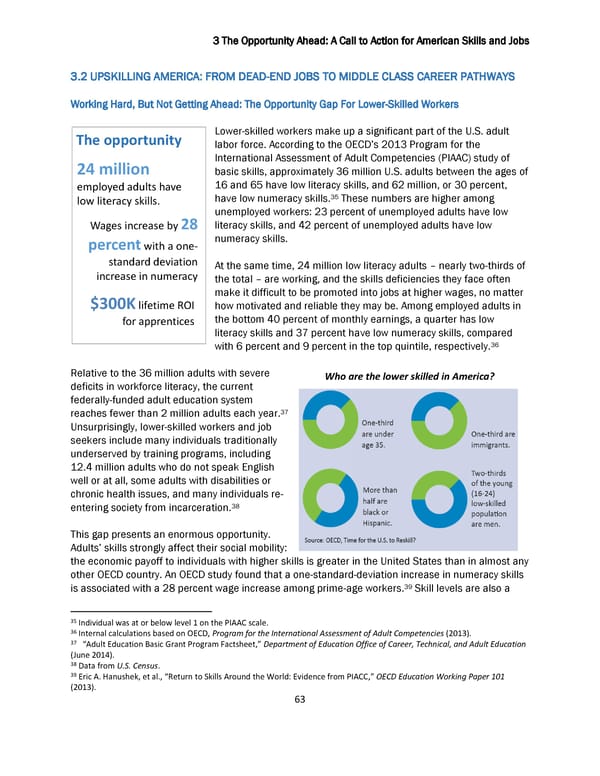3 The Opportunity Ahead: A Call to Action for American Skills and Jobs 3.2 UPSKILLING AMERICA: FROM DEAD-END JOBS TO MIDDLE CLASS CAREER PATHWAYS Working Hard, But Not Getting Ahead: The Opportunity Gap For Lower-Skilled Workers Lower-skilled workers make up a significant part of the U.S. adult The opportunity labor force. According to the OECD’s 2013 Program for the 24 million International Assessment of Adult Competencies (PIAAC) study of basic skills, approximately 36 million U.S. adults between the ages of 16 and 65 have low literacy skills, and 62 million, or 30 percent, employed adults have 35 low literacy skills. have low numeracy skills. These numbers are higher among unemployed workers: 23 percent of unemployed adults have low Wages increase by 28 literacy skills, and 42 percent of unemployed adults have low numeracy skills. percent with a one- standard deviation At the same time, 24 million low literacy adults – nearly two-thirds of increase in numeracy the total – are working, and the skills deficiencies they face often skills make it difficult to be promoted into jobs at higher wages, no matter $300K lifetime ROI how motivated and reliable they may be. Among employed adults in for apprentices the bottom 40 percent of monthly earnings, a quarter has low literacy skills and 37 percent have low numeracy skills, compared with 6 percent and 9 percent in the top quintile, respectively.36 Relative to the 36 million adults with severe Who are the lower skilled in America? deficits in workforce literacy, the current Who Are the Low-Skilled in America? federally-funded adult education system reaches fewer than 2 million adults each year.37 Unsurprisingly, lower-skilled workers and job seekers include many individuals traditionally underserved by training programs, including 12.4 million adults who do not speak English well or at all, some adults with disabilities or chronic health issues, and many individuals re- 38 entering society from incarceration. This gap presents an enormous opportunity. Adults’ skills strongly affect their social mobility: the economic payoff to individuals with higher skills is greater in the United States than in almost any other OECD country. An OECD study found that a one-standard-deviation increase in numeracy skills 39 is associated with a 28 percent wage increase among prime-age workers. Skill levels are also a 35 Individual was at or below level 1 on the PIAAC scale. 36 Internal calculations based on OECD, Program for the International Assessment of Adult Competencies (2013). 37 “Adult Education Basic Grant Program Factsheet,” Department of Education Office of Career, Technical, and Adult Education (June 2014). 38 Data from U.S. Census. 39 Eric A. Hanushek, et al., “Return to Skills Around the World: Evidence from PIACC,” OECD Education Working Paper 101 (2013). 63
 Biden Ready to Work White Paper 7/22/14 Page 62 Page 64
Biden Ready to Work White Paper 7/22/14 Page 62 Page 64